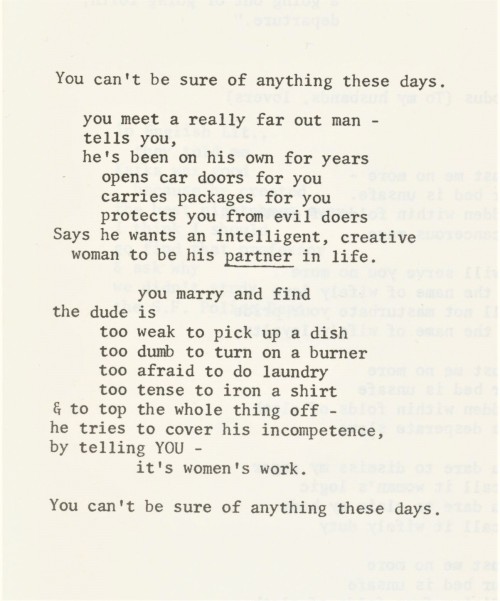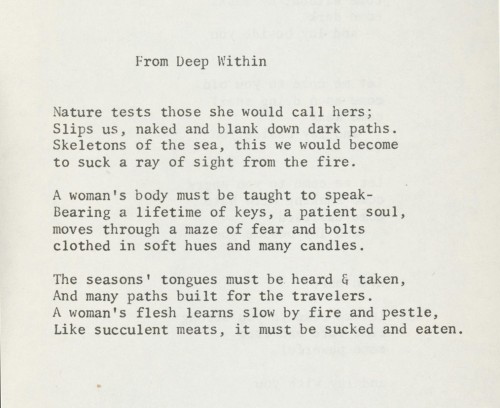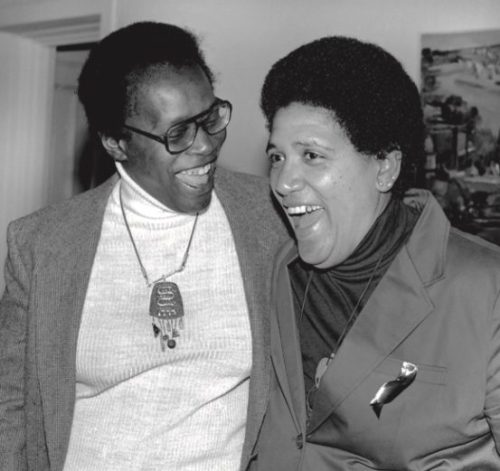#womens liberation
Staff Pick of the Week
Child of Myself
Our collection preserves a second printing of American poet and activist Pat Parker’s first poetry book, Child of Myself, published in 1974 by the Women’s Press Collective.The illustrations for this printing were done by Brenda Crider, Wendy Cadden, Jerri Robertson, Karen Garrison, and “Helle.” Over the course of her life, Parker published five collections of poetry and was a champion in the fight for women’s and LGBT liberation.
Parker’s activism was extensive. Parker was the founder of the Black Women’s Revolutionary Council in 1980; an early supporter of groups like the Black Panther Party; and the executive director of the Oakland Feminist Women’s Health Center from 1978 to 1987—a revolutionary organization, offering abortion healthcare to women in California, which inspired the formation of the still active, Chico Feminist Women’s Health Center (CFWHC). She also aided in the formation of the Women’s Press Collective, the publisher of her first two poetry books. The Collective was established by photographer, printer, and publisher,Wendy Cadden, and her partner Judy Grahn, an Air Force officer turned poet and activist after being discharged for being openly gay. Producing books, poems, and graphics, the press strove to promote work by lesbians disenfranchised by race or class.
InChild of Myself, Parker challenges the socially accepted power dynamics of heterosexual relationships through critiques on women’s prescribed roles as housekeeper and caretaker. When reading Parker’s stream-of-consciousness poetics, we have to step back and appreciate the bravery of these Black, LGBT, women feminists, who endured in the face of multiple systems of oppression. Parker and friends’ fight for women’s liberation was even acknowledged by Black Panther Party Leader, Huey P. Newton, in a 1970 interview:
…we say that we recognize the women’s right to be free. We have not said much about the homosexual at all, but we must relate to the homosexual movement because it is a real thing. And I know through reading, and through my life experience and observations that homosexuals are not given freedom and liberty by anyone in the society. They might be the most oppressed people in the society.
Child of Myself was originally published in 1972 by Shameless Hussy Press, founded byAlta Gerrey in Oakland in 1969—the first feminist press in the United States! The release of this first poetry book was just the beginning of Parker’s incredible career as a champion for LGBT rights, coming out as lesbian after the release of her second collection, Pit Stop, published by Women’s Press Collective in 1973, and again in 1975. Parker’s third poetry book, Womanslaughter, published in 1978 by American feminist publishing house, the Diana Press, revolves around the issue of femicide and the trauma of domestic violence. Parker often spoke publicly about these issues, kicking off day three of the first National Conference of Third World Lesbians and Gays, on October 15th, 1979, in Washington, D.C., with a speech about her sister’s tragic death at the hands of her husband.
Due to the Diana Press’s closure in 1979, Parker’s fourth collection, Movement in Black, published by the press in 1978, went out of print until 1983, when the Crossing Press (now a part of Random House’sCrown Publishing Group) issued a facsimile edition of the collection. By 1987 the book was once again unavailable, until, shortly after Parker’s death in 1989, Firebrand Books published its first edition of the collection—this time, including a foreword by friend, poet, and fellow activist, Audre Lorde and an introduction by Judy Grahn. Ten years later, in 1999, Firebrand released An Expanded Edition of Movement In Black, which includes a new section of previously-unpublished work, an introduction by Cheryl Clarke, and “Celebrations, Remembrances, Tributes” by ten Black writers including Lorde,Angela Y. Davis,Pamela Sneed, and Barbara Smith (founder of Kitchen Table: Women of Color Press).
Parker’s fifth and final poetry collection, Jonestown & Other Madness, was originally published by Firebrand Books in 1985, then re-published in 1989, just before Parker’s death from breast cancer. If you click here, you can hear Parker read the title poem from the book. Parker’s legacy will not soon be forgotten. In June 2019, Parker was one of the inaugural fifty American “pioneers, trailblazers, and heroes” inducted on the National LGBTQ Wall of Honor at the Stonewall National Monument (SNM) in New York City’s Stonewall Inn. In 1991, thePat Parker/Vito Russo Center Library, was founded to encourage and facilitate the reading and research of LGBT literature.
Viewother Staff Picks here!
–Isabelle, Special Collections Undergraduate Writing Intern
Author Portrait from the National Black Justice Coalition
Picture of Parker and Audre Lorde courtesy of Susan Fleischmann, 1981, with permission of Public Books.
If you or someone you know is suffering from domestic violence and looking for help, don’t hesitate to reach out to the free, 24/7,hotline through text, chat, or call at 800-799-7233.
Post link
Happy International Women’s Day!
Remembering the ‘Fearless’ Dickey Chapelle, American’s first female war correspondent photojournalist who brought her camera to combat fields from World War II through the Vietnam War. Chapelle was killed in action while covering the Vietnam War.
Post link
#FightTogetherWithShiori
This is the first woman in Japan to speak out in a high profile sexual assault case against a very famous journalist who has written books about Prime Minister Abe. The first of the #MeToo movement surfacing in japan was based on this case that came out May 2017 as the first brave voice to speak up.
The #MeToo movement in America has greatly helped give women the courage globally to speak up against sexual assault and violence
Now, #standtogetherwithshiori has become the Japanese #metoo and #timesup synonymous rally cry.
Friends of Japan and global women’s rights, I implore you to add #FightTogetherWithShiori to your tweet about women’s rights so you can show your support for Japanese women’s liberation
Japanese Women on Twitter: We do not like being treated like shit or being objectified and face terrible sexism every day
Mixed Race Japanese People: *translate these messages directly from Japanese women so everyone can understand*
Western Men: Wow stop trying to force your culture on Japan. Women love being treated like shit there I saw it on anime.

First issue of Seito in 1911, which became an integral part of the Japanese Women’s Rights Movement.
“The magazine’s name, Seitō, translated to “Bluestockings,” a nod to an unorthodox group of 18th-century English women who gathered to discuss politics and art, which was an extraordinary activity for their time.
But Seitō was not intended to be a radical or political publication. “We did not launch the journal to awaken the social consciousness of women or to contribute to the feminist movement,” wrote the magazine’s founder, Haruko Hiratsuka, who went by the penname Raichō, or “Thunderbird.” “Our only special achievement was creating a literary journal that was solely for women.” Raichō was most interested in self-discovery—“to plumb the depths of my being and realize my true self,” she wrote—and much of the writing in the magazine was confessional and personal, a 1910s version of the essays that might now be found in or Catapult.
Women’s feelings and inner thoughts, however, turned out to be a provocative challenge to the social and legal strictures of this era, when a woman’s role was to be a good wife and mother. The Seitō women imagined much wider and wilder emotional and professional lives for themselves. They fell in love, they indulged in alcohol, they built careers as writers, and they wrote about it all—publicly. The stories were radical enough that the government censored them. The story that prompted policemen to visit the magazine’s office late at night was a piece of fiction about a married women writing to her lover to ask him to meet her while her husband was away.
As they attracted public attention and disapproval, instead of shying away from the controversy they’d created, the editors of Seitō were forced to confront more baldly political questions, and this in turn earned them more banned issues. In the pages of their magazine they came to debate women’s equality, chastity, and abortion. Without originally intending to, they became some of Japan’s pioneering feminists.”
-Excerpt from HERE documenting women’s history in Japan
Barbara Smith, “Racism and Women’s Studies”, All the Women are White, all the Blacks are Men, But Some of Us Are Brave, p. 49.
Post link
Support true equality for women on International Women’s Day by taking a stand against pornography! ♥ #IWD2015 ❤ ~~
Pornography is anti-woman propaganda, and women will never be fully equal and free until EVERYONE says NO to pornography. ✖
AntiPornography.org
Post link
Whistleblower teacher makes shocking claim that ‘most are autistic’
Transing of children is abuse and the legally sanctioned medical experimentation of pharmaceuticals on youth. All puberty blockers are simply drugs that are prescribed for off-label use. The most frequently prescribed is Lupron, a powerful chemotherapy drug made only and specifically for palliative care during end-stage advanced prostate cancer. It was originally developed for and prescribed to patients who were dying, and not expected to recover, as a last resort.
Now, this drug - which is also given to pedophiles as a form of chemical castration - is a so-called “puberty blocker”. It was developed by Takeda-Abbott (TAP) Pharmaceuticals. In 2001, TAP paid an industry-record $885 million and pleaded guilty to a criminal charge of conspiring with doctors to bill government health insurers for free samples of Lupron; they provided kickbacks to doctors for prescribing the drug for off-label use. Whistleblower Dr. David B. Redwine claimed he was offered $100,000 to find reasons to prescribe the drug to patients. The company has to date paid out a record 1 billion for cases of fraud and deception about the harms of their drugs.
Transgenderism is a socially engineered marketing campaign for pharmaceutical companies which intentionally takes the guise of a human rights issue and exploits and abuses homosexual youth and children struggling with mental health and autism.
“An astonishing 17 pupils at a single British school are in the process of changing gender, The Mail on Sunday can reveal.
Most of the youngsters undergoing the transformation are autistic, according to a teacher there, who said vulnerable children with mental health problems were being ‘tricked’ into believing they are the wrong sex.”
Indonesian government persecution of feminist Anindya Joediono
A collective of Indonesian radical feminists contacted me to spread the word about Anindya Shabrina, who has been repeatedly harassed by authorities. She is going to court and faces a prison sentence for her feminist, anti-racist, and anti-poverty activism.
“In December 2017, Anindya and her company of friends began advocating against urban poor eviction by the officials, and their fight still continues today.
On July 6 2018, Anindya was attending a discussion and movie screening in a Papua students’ boarding house. The event discussed the human rights violations by the Indonesian government toward the Papuans. As a context, there’s still a high level of racism against Papuans or Melanesian groups in Indonesia; therefore, Papua-affiliated events are always seen as separatism.
During the discussion, hundreds of the government’s apparatus along with military officers barged in without any warrant and terminated the discussion. While confronting an official and asking for the warrant, Anindya was sexually harassed by one of the police members. Another woman in the location, Isabella, was dragged by them. After being dragged and harassed they were bullied by the police officers.”
“Anindya is an active Indonesian feminist-activist who is being persecuted for speaking up, not only about the sexual harassment she experienced done by a state apparatus, but also against injustice done to women and poor people in Indonesia. The government is trying to silence her by using multiple accusations.“
*****Please share using the form:******
"My name is (name) from (country) and I am here condemning the criminalization of Anindya Shabrina by Indonesian government. I am writing in support of feminists and the survivors of sexual violence of Indonesia to speak up and end all forms of persecution. Stop trying to silence women!”
The details of her case in English can be accessed through the link http://bit.ly/AninsCase2018
E-mail contact
Dead Republican brothel owner wins election in Nevada
A deceased pimp, a purveyor of rape, just defeated a living woman in Nevada’s elections.
Are you starting to realize how much women are hated?
The 98 US Candidates who want to eliminate Title IX sex-based protections for women
US Sisters:
The fight is far from over.
As you know we are trapped between the right and the left, and neither fully represents the needs of women.
As Dworkin said, the right sees women as private property; the left sees women as public property.
Here is a list of Democrat politicians who have promised to remove Title IX, eroding sex-based protections for women.
Please contact your representative encouraging them to uphold the legal definition of woman. We are oppressed in order for men to access our bodies; we are oppressed on the basis of sex.
“In a remarkable letter released just days before the 2018 mid-term elections, 98 candidates declared their intention to eliminate Title IX sex-based equality protections for women, replacing the protected category of "sex’ with ‘gender identity’ - a nebulously defined legal category based on an individual’s subjective identification with a social sex role defined by adherence to sex-stereotypes.
The signatories all state that legal rights for women which mandate equality based on sex are 'cruel’ to males, and 'unscientific’.”
Transgenderism is a false flag
The only forms of rebellion the system allows are those which create the illusion of choice while benefitting the status quo.
Black rights activists are still murdered. Indigenous activists are still murdered. Environmentalists are still murdered. Women are still murdered.
Transgenderism is a false, sanctioned form of rebellion that falls within a framework of the oppressive, capitalist system. It benefits pharmaceutical industries and relies on patriarchy’s lie that gender stereotypes are innate.
The system creates the problem and sells a solution. Gender dysphoria is real, as any woman can attest. Gender, however, is not.
All forms of rebellion can be absorbed into the capitalist framework, especially through the sale of selfhood as an external marker. Under such defense, nothing is sacred and any idea or identity may be bought; there are no limits to what can become a commodity.
This is why activists who pursue changing the system are killed, why transgenderism as an ideology is being embraced worldwide by governments who understand that it benefits men and legally erases patriarchy.
Those who oppose this way of thinking are murdered; those who adopt it as a person choice become lauded mascots.
How do you immediately understand that transgenderism is a false flag?
By how quickly it has been embraced by celebrities and politicians, and how very quickly laws are being changed globally.
Reminder: the US never passed the ERA granting women equal rights.
We have so much work to do. We are on the brink of mass extinctions. What better way to divert from global ecological crises than to label biology itself as socially constructed by men, and who better fit to encourage bio-denial than corporations and celebrities?
It makes complete sense that the death throes of an obsolete system collectively resort to violent gnashings against nature and biology itself, at a time when our very survival as a species depends on healing biological systems.
Anyone who cares about the survival of the planet, or even of humanity itself, ought to shun outright the concept of becoming a true “self” through toxic chemicals. Instead we ought to re-establish a concept of selfhood through actions as opposed to perceptions.
Indeed, human self-identity is also at odds with the survival of the planet, as long as we shape it as dependent on external means.
You can never buy an identity, or medicate yourself into existence; in truth, your existence is nothing but part of an ecological system.
It’s my view that transgenderism goes hand in hand with climate change; that it diverts us from our own extinction by feeding an appetite for validation, to fill a hole created by a destructive system.
So we turn inward, rather than facing our shared reality.
As much as transgenderism is biophobia, extreme societal denial of physical reality, it can’t exist without the very real phenomenon of womb envy, which is to say the acknowledgement that women reproduce life and men play a less significant role in continuing humanity.
Women have emphasized repeatedly that the female ability to reproduce is what men seek to control when they oppress us.
Now, they demand our silence regarding our physical differences.
We are allowed a body, or a mind; never both at the same time.
When and if society at large realizes that this has been but a stepping stone towards transhumanism, the human merging and dependence on technology for survival, it will be too late; and undoubtedly, a man will receive credit for pointing out what is quite obvious to us as women.
I am a woman.
I am not a feminine stereotype.
Men are not and can never be women.
We exist. We have lives independent of men’s fantasies of us.
I am an adult human female and #WomenWontBeErased

So once again, the male is the authority on our lives.
That was the intention all along.

Na Hyeseok was a Korean feminist, poet, writer, painter, educator, and journalist. Her pen name was Jeongwol. She was the first female professional painter and the first known feminist writer in Korea.
As a young woman, Na was known for her high spirits and outspokenness, making it clear she wanted to be a painter and an intellectual, rejecting the traditional “good wife, good mother” archetype.
Her major written work, Kyonghui (경희), published in 1918, concerns a woman’s self-discovery and her subsequent search for meaning in life as a “new woman;” it is the first feminist short story in Korean literature.
In 1919, she participated in the March 1st Movement against Japanese rule. She was jailed for this, and the lawyer hired by her family to represent her soon became her husband.
She challenged the patriarchal social system and male-oriented mentality of Korean society at the time. In “A Divorce Confession”, Na criticized the repression of female sexuality; stated that her ex-husband had been unable to satisfy her sexually and refused to discuss the issue; and finally she advocated “test marriages” where a couple would live together before getting married to avoid a repeat of her unhappy marriage. It was “A Divorce Confession” that ruined Na’s career as her views were regarded as scandalous and shocking as in traditional Korean Confucian culture premarital sex was regarded as taboo and women were not to speak frankly of their sexuality.
Unable to sell her paintings, essays or stories, Na was reduced to destitution and spent her last years living on the charity of Buddhist monasteries.
Her fate was often used to scold young Korean woman who had literary or artistic ambitions; “Do you want to become another Na Hye-sok?” was a frequent reprimand to daughters and younger sisters. However, she has recently been acknowledged in Korea for her artistic and literary accomplishments.
Men use patriarchy as a tool to remove women’s right to natural selection, so that men do not have to be judged by the same standards they apply to women; the end result is that even the most physically mediocre male may have access to a woman if he displays personal characteristics which uphold male dominance.

Kanno Sugako (1881–1911), was a Japanese radical anarcho-feminist.
She was the first woman to be executed in modern Japan for political reasons, at the age of 29, for having led a plot to overthrow the government - which was building a new economy on the backs of girls sold in slavery to textile factories during the Meiji period.
Later, when the judge asked Kanno if she wished to make a final statement, she stated her only regret was that the plot failed.
I learned about her from a book called “Flowers in Salt” by Sharon Sievers about the modern beginnings of feminism in Japan.
It’s a heartbreaking book.
Japan wanted to modernize after seeing the threat of US technology in the late 1800s. The government was able to create a trade economy due to the literal enslavement of women and girls in textile factories.
Companies visited rural towns promising a better life for young women. Farming parents believed their daughters would have more opportunities if they could support themselves, and the government created propaganda to this aim.
Girls as young as 6 walked through the mountains to the factories with no shoes, so it was eventually called a trail of blood.
Later, towns caught on, and when a company came to collect girls, they protested, and were met with violence.
(Resistance to company collection of girls actually sparked one of the first modern labor protests in Japan.)
Female workers were locked in, and the dorms were a prison. The invention of lamps meant that working hours extended to as much as 36 hours at a time. Their handwoven textiles were exported for company profit, and male overseers raped them.
There are anecdotes of men finding women’s bodies near the factories, where they had escaped just long enough to kill themselves.
Kanno lived at a time when this was happening, and had been raped herself when she was fifteen. She wanted to stop the government expansion which was coming at the expense of human rights.
The modern economy of Japan was created through enslaving and selling women and girls.
And as radical feminists know, that hasn’t ended. All economies are built on women’s slavery in one way or another.

Happy birthday to Mae Jemison!
Mae Carol Jemison (born October 17, 1956) is an American engineer, physician and NASA astronaut. She became the first African American woman to travel in space when she went into orbit aboard the Space Shuttle Endeavour on September 12, 1992. After medical school and a brief general practice, Jemison served in the Peace Corps from 1985 until 1987, when she was selected by NASA to join the astronaut corps. She is a dancer and holds nine honorary doctorates in science, engineering, letters, and the humanities.
Women in prison punished more harshly than men around the country
“INVESTIGATION: Data from 15 states reveals that female inmates are disciplined at significantly higher rates than men most often for smaller, nonviolent offenses in prisons across the country.”
Same-sex mouse parents give birth via gene editing
“Only pups with two moms survived to have babies themselves.”
Because the Y is a deteriorated X.
Epic Gallery: 150 Years Of Lesbians And Other Lady-Loving-Ladies
Happy National Coming Out Day to all my lesbian sisters
“No genuine social revolution can be accomplished by the male, as the male on top wants the status quo, and all the male on the bottom wants is to be the male on top. The male ‘rebel’ is a farce; this is the male’s ‘society,’ made by him to satisfy his needs.”
SCUM Manifesto — Valerie Solanas












